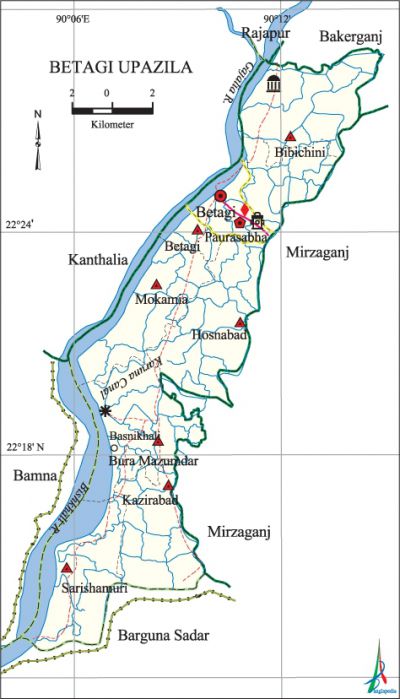Betagi Upazila
Betagi Upazila (barguna district) area 167.75 sq km, located in between 22°13' and 22°29' north latitudes and in between 90°04' and 90°15' east longitudes. It is bounded by bakerganj and rajapur upazilas on the north, barguna sadar upazila on the south, mirzaganj upazila on the east, Kanthalia and bamna upazilas on the west.
Population Total 117145; male 56683, female 60462; Muslim 105513, Hindu 11427, Christian 204 and others 1.
Water bodies Main rivers: bishkhali, Gajalia; Katakhali and Karuna canals are notable. Administration Betagi Thana was formed in 1920 and it was turned into an upazila in 1983.
| Upazila | ||||||||
| Municipality | Union | Mouza | Village | Population | Density (per sq km) | Literacy rate (%) | ||
| Urban | Rural | Urban | Rural | |||||
| 1 | 7 | 59 | 73 | 12786 | 104359 | 698 | 59.7 (2001) | 58.6 |
| Municipality | ||||||||
|
Area |
Ward |
Mahalla |
Population |
Density |
Literacy rate | |||
| 4.1 (2001) | 9 | 9 | 10204 | 449 (2001) | 76.4 | |||
| Upazila Town | ||||||||
|
Area |
Mouza |
Population |
Density |
Literacy rate | ||||
| 3.62 (2001) | 2 | 2582 | 687 (2001) | 54.3 | ||||
| Union | ||||
| Name of union and GO code | Area (acre) | Population | Literacy rate (%) | |
| Male | Female | |||
| Kazirabad 59 | 4909 | 6953 | 7294 | 57.4 |
| Bibichini 23 | 6237 | 8365 | 8982 | 59.1 |
| Bura Mazumdar 35 | 5963 | 6766 | 7250 | 60.9 |
| Betagi 11 | 5638 | 7539 | 8218 | 62.0 |
| Mokamia 71 | 5157 | 6853 | 7312 | 59.4 |
| Sarishamuri 83 | 6093 | 7206 | 7927 | 58.3 |
| Hosnabad 47 | 6442 | 7890 | 8386 | 53.0 |
Source Bangladesh Population Census 2011, Bangladesh Bureau of Statistics.

Archaeological heritage and relics Bibichini Shahi Mosque.
War of Liberation During the war of liberation the Pak army set the eastern extremity of Betagi Bazar on fire and caused heavy damages to properties. A number of Pakistani soldiers and razakars were killed in a frontal encounter between the freedom fighters and the Pak army at Badnikhali Bazar of Bura Mazumdar union; besides, the motor launch MV Munir carrying the Pak army was seriously damaged.
For details: see বেতাগী উপজেলা, বাংলাদেশ মুক্তিযুদ্ধ জ্ঞানকোষ (Encyclopedia of Bangladesh War of Liberation), বাংলাদেশ এশিয়াটিক সোসাইটি, ঢাকা ২০২০, খণ্ড ৭।
Religious institutions Mosque 460, church 1, tomb 4, sacred place 2.
Literacy rate and educational institutions Average literacy 60.1%; male 62.5%, female 57.9%. Educational institutions: college 7, secondary school 22, primary school 140, madrasa 58. Noted educational institutions: Betagi Degree College (1999), Betagi Business and Tecnical College (2004), Nurjahan Business and Tecnical College (2004), Kaunia Emdadia secondary school (1906), Betagi Secondary School (1941), Chandkhali Secondary School (1959), Lakshmipur Rahmatia Secondary School, Mokamia Fazil Madrasa (1935).
Newspapers and periodicals Fortnightly: Bishkhali, Betagir Kantha; Defunct: Betagir Kantha.
Cultural organisations Library 2, club 32, literary group 2, women's organisation 2, cinema hall 2.
Main sources of income Agriculture 61.29%, non-agricultural labourer 3.04%, industry 0.44%, commerce 13.33%, transport and communication 1.37%, service 8.94%, construction 1.55%, religious service 0.19%, rent and remittance 0.24% and others 9.61%.
Main crops Paddy, wheat, corn, potato, khesari, mug, ground nut, vegetables.
Extinct or nearly extinct crops Jute, sesame, mustard.
Main fruits Banana, jackfruit, mango, coconut, hog-plum, papaya, Palmyra-fruit, wood-apple.
Fisheries, dairies and poultries Dairy 15, poultry 17, hatchery 2.
Communication facilities Pucca road 102 km, semi-pucca road 29 km, mud road 1138 km; waterway 512 km.
Extinct or nearly extinct traditional transport Palanquin.
Noted manufactories Rice mill, saw mill, ice factory, storage battery workshop.
Cottage industries Goldsmith, blacksmith, wood work, embroidery, bamboo and cane work.
Hats, bazars and fairs Hats and bazars are 18, fairs 3, most noted of which are Badnikhali Hat, Kazir Hat, Mollar Hat, Kaunia Hat; Betagi Bazar, Mokamia Bazar, Chandkhali Bazar and Kabirajbari Mela and Bura Majumdar Kacharibari Mela.
Main exports Paddy, rice, khesari, banana.
Access to electricity All the wards and unions of the upazila are under rural electrification net-work. However 30.0% of the dwelling households have access to electricity.
Sources of drinking water Tube-well 96.0% and others 4.0%.
Sanitation 78.2% of dwelling households of the upazila use sanitary latrines and 20.6% of dwelling houses use non-sanitary latrines; 1.2% of households do not have latrine facilities.
Health centres Upazila health centre 1, satellite clinic 7, union health and family welfare centre 7, family planning centre 1.
NGO activities Operationally important NGOs are brac, asa. [Saidul Islam Mantu]
References Bangladesh Population Census 2001 and 2011, Bangladesh Bureau of Statistics; Cultural survey report of Betagi Upazila 2007.
